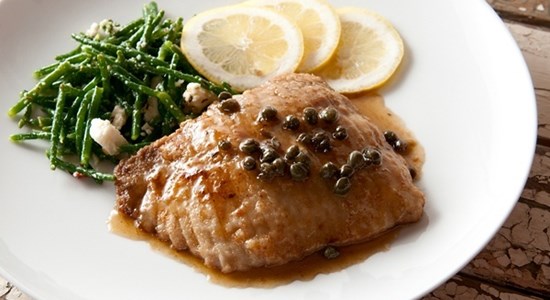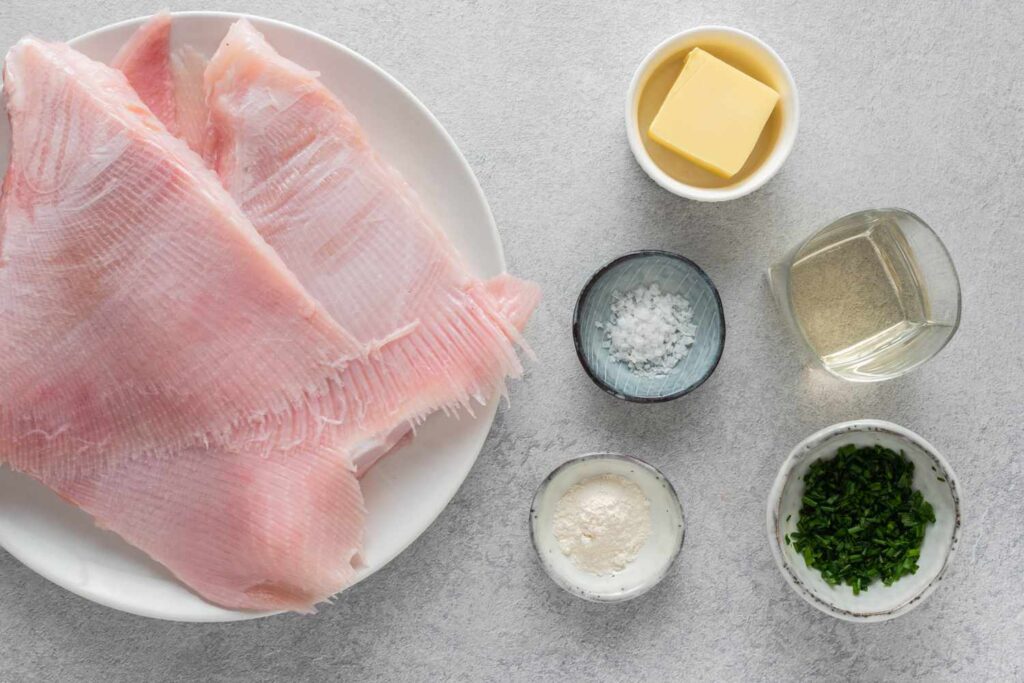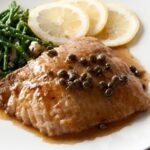The Whispering Wings of the Sea: Pan-Fried Skate with Capers and Beurre Noir – A Culinary Odyssey
The kitchen, at this very moment, is a sanctuary. Sunlight streams through the window, illuminating dust motes dancing in the air, and a gentle hum of anticipation vibrates within its walls. Today, we embark on a culinary journey, a voyage to the depths of flavor and texture, guided by the delicate wings of the sea: skate. Not just any skate, mind you, but pan-fried skate, kissed by the heat of the pan to a perfect golden-brown, adorned with the briny jewels of capers, and draped in the luxurious, nutty embrace of beurre noir.
This isn’t merely a recipe; it’s an experience. It’s about transforming simple ingredients into a symphony of sensations, a testament to the elegance that can be achieved with thoughtful preparation and a touch of culinary artistry. Forget the mundane; today, we elevate the humble skate to a dish worthy of the most discerning palate.
For those unfamiliar, skate, with its distinctive wing-like shape, offers a unique texture – tender, almost flaky, with a subtle sweetness that lends itself beautifully to bold flavors. It’s a canvas waiting to be painted, and our chosen palette of capers and beurre noir promises a masterpiece. The sharpness of the capers cuts through the richness of the butter, while the “black butter,” with its nutty aroma and slightly bitter edge, adds a layer of complexity that is both intriguing and utterly delicious.
This blog post is more than just a list of instructions. It’s a deep dive into the world of skate, an exploration of the nuances of beurre noir, and a celebration of the simple yet profound pleasure of a perfectly cooked meal. We’ll delve into the best practices for sourcing your skate, the secrets to achieving that coveted crispy exterior, and the art of crafting a beurre noir that sings on the tongue. So, pull up a chair, pour yourself a glass of something crisp and white, and let’s embark on this culinary adventure together.

(Understanding Our Star: The Magnificent Skate)
Before we even think about the sizzle of the pan or the aroma of melted butter, let’s take a moment to appreciate our protagonist: the skate. Often overlooked in favor of more mainstream fish, skate possesses a charm and a culinary versatility that deserves recognition.
What Exactly is Skate?
Skate belongs to the ray family, characterized by their flattened bodies and wing-like pectoral fins. These “wings” are the prized part of the fish, offering firm, yet delicate flesh separated by cartilaginous rays rather than bones. This unique structure makes it incredibly easy to eat, as the flesh simply flakes away from the cartilage.
A Sustainable Choice?
In an age where sustainability is paramount, it’s crucial to consider the origins of our food. Fortunately, many skate populations are considered sustainable when caught using responsible fishing methods. Look for skate that has been sourced from well-managed fisheries. Your fishmonger should be able to provide information on the origin and fishing method of their skate. Choosing sustainable options ensures that we can continue to enjoy this delicious fish for years to come.
The Flavor Profile and Texture:
The flavor of skate is often described as mild and slightly sweet, with a delicate oceanic hint. It’s not as intensely “fishy” as some other varieties, making it appealing even to those who are sometimes hesitant about seafood. The texture is where skate truly shines. When cooked properly, the flesh becomes incredibly tender and flaky, almost melting in your mouth. It’s this delicate texture that makes it such a wonderful partner for both subtle and bold flavors.
Preparing Skate for Culinary Glory:
Freshness is key when it comes to skate. Look for firm flesh that springs back to the touch and has a clean, briny aroma. Avoid any fish that smells overly fishy or has a slimy texture.
The preparation of skate is relatively straightforward. Typically, the “wings” are sold already cleaned and skinned. However, it’s always a good idea to give them a good rinse under cold water and pat them thoroughly dry with paper towels. This step is crucial for achieving that perfect crispy crust when pan-frying. Excess moisture will steam the fish rather than allowing it to sear.
(The Magic of Beurre Noir: More Than Just Burnt Butter)
Now, let’s turn our attention to the supporting star of our dish: beurre noir. Often translated simply as “black butter,” this classic French sauce is so much more than just butter that has been cooked a little too long. It’s a transformation, a metamorphosis of simple fat into a complex and deeply flavorful elixir.
The Art of Controlled Transformation:
The key to a perfect beurre noir lies in controlled cooking. We’re not aiming for burnt butter in the accidental sense; we’re guiding the butter through stages of melting, foaming, and finally, browning, coaxing out nutty and toasty aromas and a rich, deep flavor.
The Science Behind the Sizzle:
As butter melts, the water content evaporates, and the milk solids begin to separate. As the heat continues, these milk solids start to brown, releasing a cascade of aromatic compounds that give beurre noir its signature nutty fragrance. This browning process needs to be carefully monitored. Too little, and you miss out on the depth of flavor; too much, and you end up with acrid, truly burnt butter. The sweet spot is a deep golden-brown, verging on hazelnut in color, with a fragrant, nutty aroma.
Beyond Butter: The Essential Additions:
While browned butter forms the foundation, a classic beurre noir typically includes a touch of acidity to balance the richness. This is usually achieved with a splash of vinegar, often red wine vinegar or white wine vinegar, or a squeeze of fresh lemon juice. The acidity cuts through the fat, adding a bright counterpoint that elevates the entire sauce.
Fresh parsley is another common and welcome addition. Its vibrant green color and fresh, herbaceous notes provide a visual contrast and a refreshing element to the sauce.
The Symphony of Capers:
Our third key player, the caper, brings a burst of briny, salty, and slightly tangy flavor to the dish. These tiny pickled flower buds add a delightful pop that complements both the delicate sweetness of the skate and the rich nuttiness of the beurre noir.
Choosing Your Capers:
Capers come in various sizes, from the tiny non-pareil to the larger grusas. For this dish, non-pareil or capucines (small to medium-sized) are ideal, offering a good balance of flavor and texture.
Preparing Capers for Maximum Impact:
While capers are delicious straight from the jar, a quick rinse under cold water can help to remove some of the excess brine, allowing their more nuanced flavor to shine through. Patting them dry will also help them to retain their texture when added to the hot beurre noir.

(The Culinary Crescendo: Pan-Frying the Skate and Assembling the Dish)
Now, with our skate prepped and our understanding of beurre noir and capers firmly in place, it’s time for the main event: pan-frying the skate to golden perfection and bringing all the elements together.
Achieving the Perfect Sear:
The key to beautifully pan-fried skate is to achieve a crispy, golden-brown exterior while keeping the inside moist and tender. Here’s how:
- Pat it Dry: We’ve mentioned this before, but it bears repeating. Ensure the skate wings are thoroughly dry. Any excess moisture will hinder browning.
- Season Generously: Season both sides of the skate wings generously with salt and freshly ground black pepper. Don’t be shy; this is your opportunity to build flavor from the very beginning. A light dusting of all-purpose flour or rice flour can also help to create a crispier crust. If using flour, make sure to shake off any excess.
- Heat the Pan: Choose a large, heavy-bottomed skillet, preferably cast iron or stainless steel, as these retain heat evenly. Place the pan over medium-high heat.
- The Right Fat: Add a combination of butter and oil to the pan. The oil (such as neutral vegetable oil or clarified butter) has a higher smoke point than butter alone, preventing it from burning too quickly, while the butter adds richness and flavor to the crust. About 2-3 tablespoons of fat should be sufficient for a couple of skate wings.
- Sizzle, Don’t Crowd: Once the fat is shimmering and hot, carefully place the skate wings in the pan, skin-side down first if the skin is still attached. Be careful not to overcrowd the pan, as this will lower the temperature and result in steaming rather than searing. Cook the skate in batches if necessary.
- Patience is Key: Let the skate cook undisturbed for several minutes, allowing a beautiful golden-brown crust to form. The cooking time will depend on the thickness of the skate, but typically it takes about 3-5 minutes per side. You’ll know it’s ready to flip when it releases easily from the pan.
- Gentle Finish: Once both sides are golden brown and the flesh is opaque and flakes easily with a fork, the skate is cooked. Remove it from the pan and set it aside on a warm plate.
Crafting the Perfect Beurre Noir:
Now, using the same pan (if it’s not overly burnt; if it is, wipe it clean and start again), let’s create our beurre noir:
- Melt the Butter: Add a generous amount of unsalted butter to the pan – about 4-6 tablespoons should be sufficient for a couple of skate wings.
- Watch the Transformation: Melt the butter over medium heat. It will start to foam. Continue cooking, swirling the pan occasionally, until the foaming subsides and the butter begins to turn a deep golden-brown, emitting a nutty aroma. Watch it carefully at this stage, as it can go from beautifully browned to burnt very quickly. You’ll see dark brown specks forming at the bottom of the pan – these are the caramelized milk solids, the essence of beurre noir.
- The Tangy Kiss: Once the butter has reached that perfect nutty brown stage, remove the pan from the heat and immediately add your chosen acid – a tablespoon or two of red wine vinegar, white wine vinegar, or fresh lemon juice. Be careful, as it will sizzle and steam. The acidity will halt the cooking process and add a crucial balance to the richness of the butter.
- The Briny Burst: Stir in the rinsed and dried capers. The heat of the beurre noir will warm them slightly, releasing their briny goodness.
- The Fresh Finale: Finally, stir in a tablespoon or two of freshly chopped parsley, adding a vibrant color and a fresh, herbaceous note.
Assembling the Masterpiece:
Now for the most rewarding part: bringing it all together.
- Plate the Skate: Place the beautifully pan-fried skate wings on individual plates.
- Drizzle Generously: Spoon the warm beurre noir with its capers and parsley generously over the skate. Ensure each piece is well-coated in the flavorful sauce.
- Garnish (Optional but Recommended): A sprinkle of extra fresh parsley, a wedge of lemon for an extra squeeze of brightness, or even some toasted almonds can add a final flourish.
(Serving Suggestions and Culinary Companions)
This pan-fried skate with capers and beurre noir is a dish that stands beautifully on its own, but it also pairs wonderfully with a variety of accompaniments.
Classic Pairings:
- Potatoes: Simple boiled or steamed potatoes, perhaps tossed with a little butter and fresh herbs, are a classic and comforting accompaniment. Roasted potatoes or a creamy potato gratin would also be delightful.
- Green Vegetables: Steamed or sautéed green beans, asparagus, or spinach provide a lovely contrast in color, texture, and flavor. A simple side salad with a light vinaigrette would also work well.
- Crusty Bread: Don’t forget some good crusty bread to soak up every last drop of that glorious beurre noir.
Wine Pairing Suggestions:
A crisp, dry white wine with good acidity is the perfect partner for this dish. Consider:
- Sauvignon Blanc: Its herbaceous notes and refreshing acidity will cut through the richness of the butter and complement the briny capers.
- Pinot Grigio: A light and crisp Pinot Grigio offers a clean and refreshing counterpoint to the flavors of the dish.
- Dry Riesling: A dry Riesling with its bright acidity and subtle minerality can also be a fantastic match.
(Beyond the Recipe: Exploring Variations and Tips)
While the classic combination of capers and beurre noir is sublime, there are always opportunities for subtle variations and improvements.
Flavor Enhancements:
- Lemon Zest: A little grated lemon zest added to the beurre noir can amplify the citrus notes.
- Shallots or Garlic: Finely minced shallots or garlic can be sautéed in the butter before it browns, adding another layer of aromatic complexity.
- Brown Butter Variations: Experiment with adding other herbs like chives or tarragon to the beurre noir for a different aromatic profile.
- Nuts: Toasted pine nuts or slivered almonds can add a delightful crunch to the sauce.
Tips for Success:
- Don’t Overcook the Skate: Skate cooks relatively quickly. Overcooking will result in dry, rubbery flesh. Cook just until it’s opaque and flakes easily.
- Keep the Butter Moving: When making the beurre noir, swirl the pan frequently to ensure the butter browns evenly and doesn’t burn.
- Taste and Adjust: Always taste your beurre noir before serving and adjust the seasoning (salt, pepper, acidity) as needed.
Pan-fried Skate with capers and beurre noir

Pan-fried skate with capers and beurre noir is an elegant and flavourful dish featuring tender skate wings pan-seared to a golden crisp, then draped in a rich, nutty "black butter" sauce studded with briny capers and fresh parsley. It's a relatively simple yet sophisticated seafood preparation that highlights the delicate taste of skate beautifully
- 4 Skate ,skinless fillets (approx. 160g each)
- Seasoning
- 50 ml Vegetable oil
- 175 g Butter
- 2 Lemon juice
- 2 tbsp Flat-leaf parsley, chopped
- 100 g Small capers
- Place a skillet on the hottest part of the stove and an empty sauté pan to the side of the stove, Achieving a moderate heat (this is for the beurre noir
- Ensure the skate wings are fresh, and free from ammonia aromas and skin. Season them with salt and pepper
- Add the vegetable oil to the skillet and place in the skate wings; cook with colour for 1-2 minutes and then carefully turn. At this point, ease the skillet to a cooler point of the stove while the beurre noir cooks
- Place the butter in the sauté pan and allow to foam (at this point remove the skate and place on the serving dish)
- Add the lemon, parsely and capers to the beurre noir and stir well
- To finish, nap over the skate wing and serve
Note
Because skate pass urine through their wings, if they are not extremely fresh they will start to smell of ammonia after three to four days . This is a key indicator of their freshness
(Conclusion: A Celebration of Simple Elegance)
Pan-fried skate with capers and beurre noir is a dish that embodies simple elegance. It’s a testament to how a few high-quality ingredients, treated with care and respect, can come together to create a truly memorable culinary experience. The delicate flavor and texture of the skate, the briny pop of the capers, and the rich, nutty embrace of the beurre noir create a symphony of flavors that is both sophisticated and deeply satisfying.
This isn’t a complicated dish, but it requires attention to detail and a willingness to engage with the process. From sourcing the freshest skate to carefully browning the butter, each step contributes to the final masterpiece. So, the next time you’re looking for a dish that is both impressive and relatively easy to prepare, I urge you to seek out the whispering wings of the sea and embark on your own culinary odyssey with this pan-fried skate with capers and beurre noir. You won’t be disappointed. It’s a taste of the ocean, elevated by the artistry of the kitchen, a reminder that sometimes, the simplest things in life – and in cooking – are often the most profound. Enjoy!
